Critical Mass: The minimum size or amount of something required to start or maintain a venture.
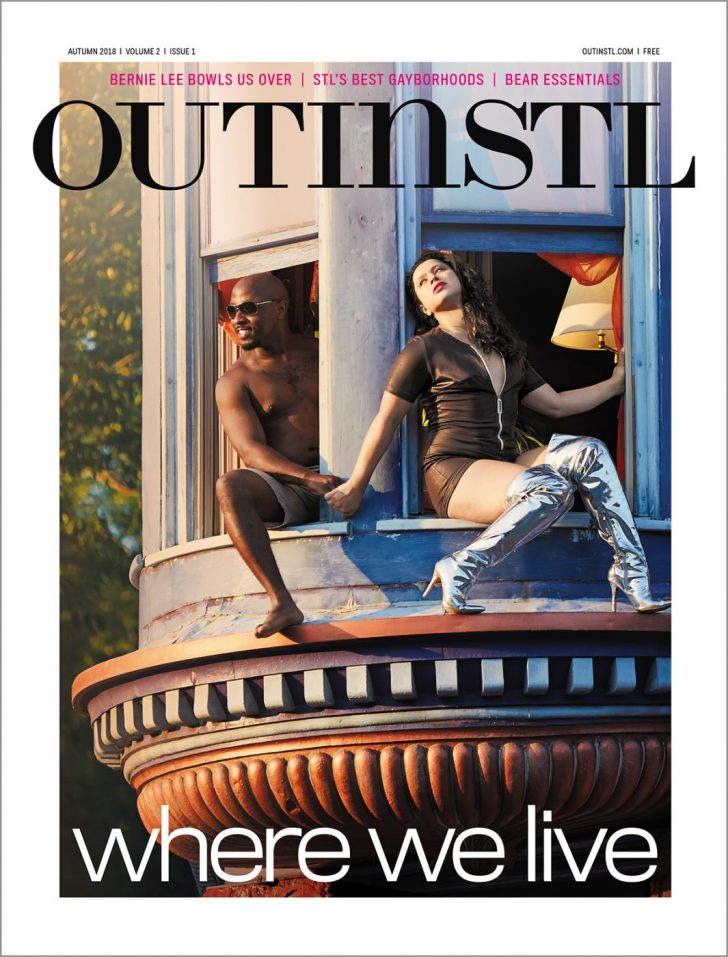
2018 cover featuring Terrence Stokes and Joss Barton
Our 2018 “Where We Live” cover story proved to be among our most widely read. Even years after it was released, readers would tell us that it had informed their decision on what neighborhoods to call home.
With the worsening political climate, LGBTQ folks and their loved ones are putting more thought than ever into where to live, so over the summer, we embarked on an update. As in 2018, we asked our readers to nominate the best residential gayborhoods across the bi-state region — but this time, we sought to get a more granular perspective, even zeroing in on specific blocks when appropriate. We were seeking walkable areas where LGBTQ folks clustered together. Friendly places you might be able to stroll down to Pride celebrations or queer businesses.
South City is one of the Midwest’s most concentrated LGBTQ ecosystems, and its neighborhoods again reigned supreme in the survey. But something big is happening across the river. 25% of the St. Louis Metropolitan Statistical Area (MSA) population resides in Illinois. In the wake of the 2024 election we’ve seen a nationwide LGBTQ migration to the blue state—one of only 19 states where marriage equality will survive if the Supreme Court reverses it. And many seem to be choosing to live in or near the two historic Metro East cities that have long made space for our community.
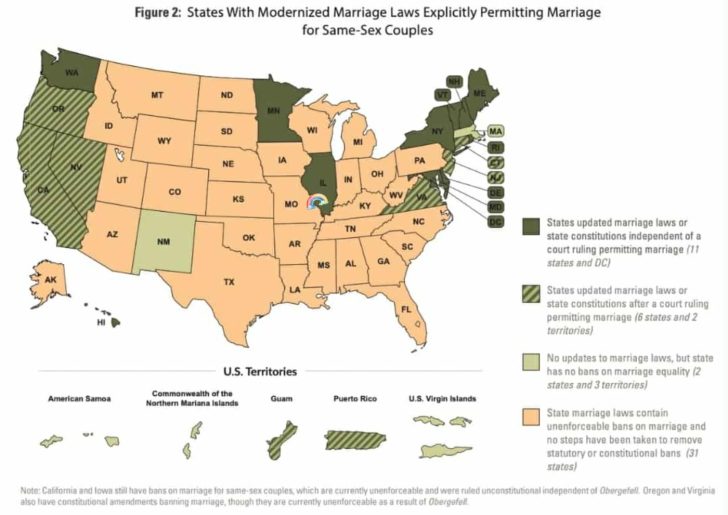
Even if marriage equality is overturned, Illinois will be a safe haven.
Our region has an abundance of distinctive options for finding your tight-knit village and putting down roots, and some of these areas are delightfully affordable. Rather than ranking them, we are presenting a slate of 12 options, and inviting you to pick your personal #1.
Best Emerging Arts Community
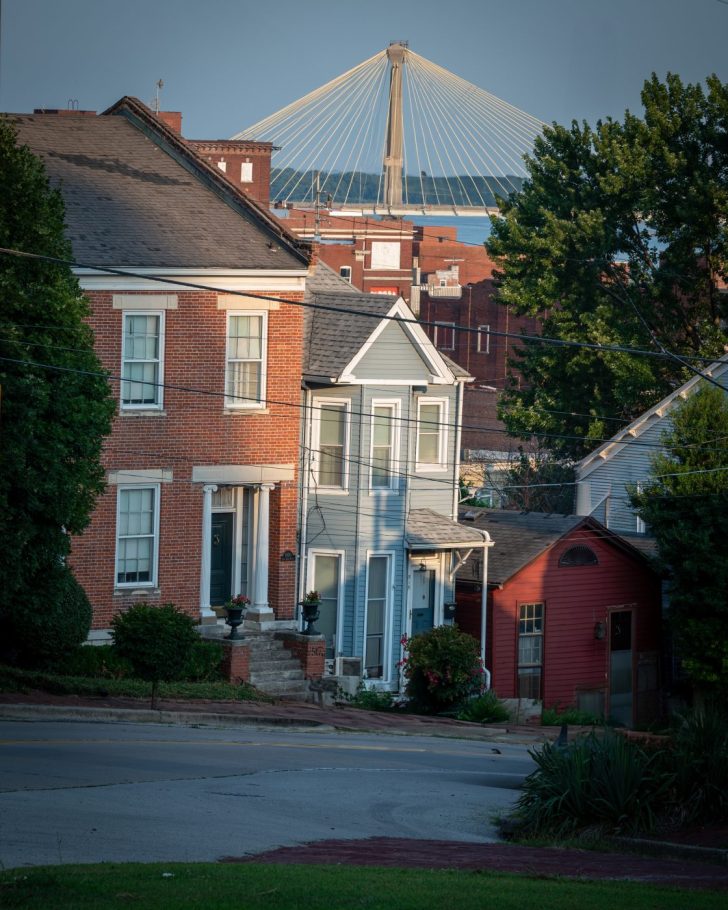
The view from Alton’s Christian Hill. Photo credit: Marty McKay
🏆Alton, Illinois: Christian Hill & Downtown
Since our first issue in 2017 we’ve been all over Alton. We’ve written about how haunted it is, and we dubbed it “The Bi-Muda Triangle” because of the sexual fluidity of many who are drawn to the town. Recently, it’s become a mecca for emerging artists. Gallery owner Charles Mooneyham is among Alton’s biggest boosters and wrote the following.
Nestled atop downtown Alton, Illinois, lies a charming enclave known as Christian Hill, a niche neighborhood dotted with quaint Queen Anne Victorian homes. From your porch, you can hear the bells of nearby churches echoing across the bluffs, their chimes cascading into the heart of downtown. It’s a place where history hums in harmony with progress.
So, what’s the gayest part of Alton? Honestly, all of it. But if you’re looking for a concentrated dose of queer magic, Christian Hill and downtown are undeniably at the epicenter. Ironically, or perhaps poetically, this historic neighborhood has become a vibrant hub for LGBTQ+ residents. Many of the homes here are proudly queer-owned, and a significant number of downtown businesses are LGBTQ+-run as well, including Bubby’s, a 30-year drag cabaret and dance club, and Mississippi Hippie, a queer owned Hippie shop and novelty store.
Alton’s progressive spirit isn’t new. It’s woven into the city’s DNA. As the home of Elijah Lovejoy, the Alton Telegraph, and a key site in the abolitionist movement, Alton has long stood on the right side of history. Lovejoy, who was murdered by a pro-slavery mob in 1837 while defending his printing press, once declared: “I have sworn eternal opposition to slavery, and by the blessing of God, I will never go back.”
That same spirit of resistance and inclusion has made Alton a refuge for LGBTQ+ individuals fleeing deep red states, seeking the security and affirmation found in Illinois’s blue wave.
In a twist of fate, many who once fled the cornfields of rural Illinois are now returning. Small river cities like Alton are becoming more progressive than urban centers in conservative states. With LGBTQ+ protections enshrined in Illinois law, Alton offers not just safety, but celebration.
And the city is booming. Multi-million-dollar investments are pouring into downtown revitalization of the city’s riverfront. Over 20 newly renovated storefronts by Alton Works and other developers will soon be available for rent and buzzing with excitement.
Organizations like Great Rivers & Routes are partnering with major cruise lines to bring tourism and sporting events to the region. Indie boutiques line the streets, alongside LGBTQ+-friendly restaurants and nightclubs. The city currently has nine art galleries or related businesses.
Then of course there is the fact that the city’s rich in music, and many of the restaurants, pubs and galleries also serve as live music venues.
One standout institution is Bubby’s and Sissy’s beloved queer bar. Having recently undergone a major facelift under new ownership, they are continuing the legacy of its founding owners and keeping Alton queer.
SEE ALSO: ALTON’S CORY DAVENPORT TAKES ON THE BULLIES

Best Community for LGBTQ Families
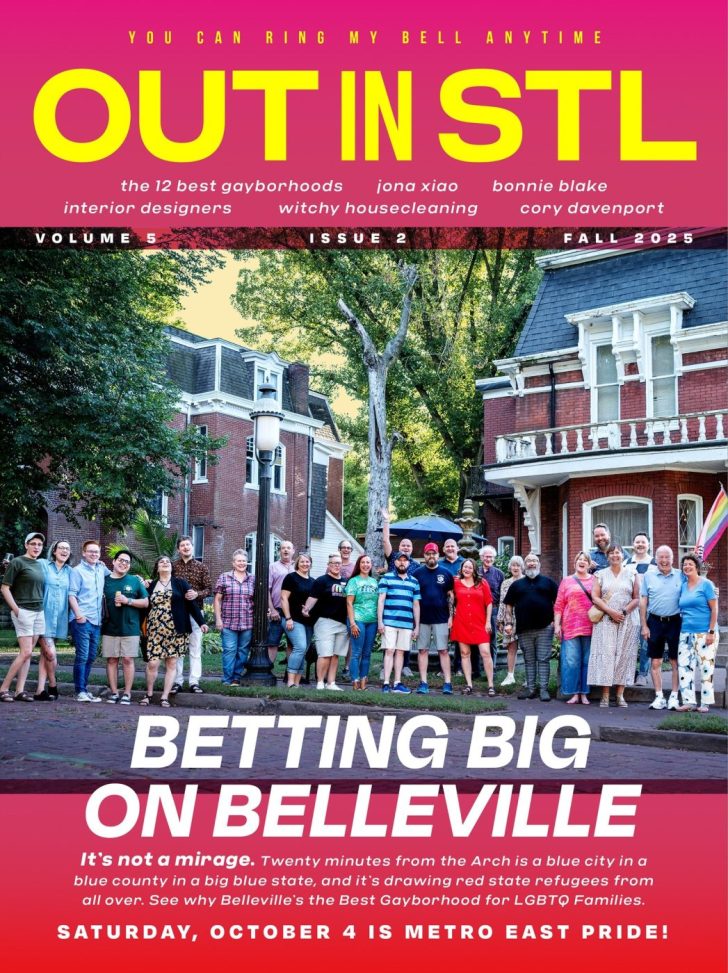
 Belleville, Illinois: Abend Historic District
Belleville, Illinois: Abend Historic District
Belleville, the county seat of St. Clair County—the bluest Illinois county south of Chicago—has long been considered a welcoming place. Home to the oldest Pride in the Metro East, the city is now drawing families from across the country, including those leaving hostile red states like Texas, in search of safety and community.
Drag artist Teighlor Demornay and her partner, Keith Owens, embody that spirit of welcome. The couple live in one of the Abend Historic District’s finest pre-Civil War homes, built in 1840. Last month, they opened its doors for a glittering soirée introducing Out In STL to Belleville’s leaders and tastemakers. Guests included Mayor Jennifer (Jenny) Gain Meyer, gay Alderman Chris Rothweiler, and Metro East Pride President Kristen Broyles.
“We want Belleville to be a community for everyone,” Mayor Meyer told us.
That commitment runs deep. Metro East Pride Vice President Mellisa Brooks, a local mom, says families from around the country reach out to ask whether LGBTQ students will be safe in Belleville schools. Her answer: yes, the district is welcoming.
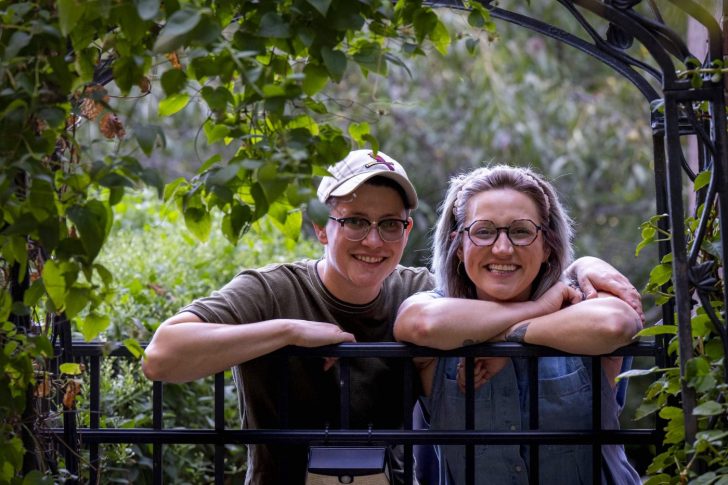
Abend residents Rose ALice and Chelsea Ann. Photo credit: Marty McKay
The night of the soirée, couples strolled the brick sidewalks with tins of food in hand, mingling in the elegant home and garden. Demornay reflected on the city’s growing queer presence.
“In the past year alone, three new LGBTQ couples have moved onto our street and the one next to it. We also have new allies who’ve joined us. People are truly free to be who they are here. My husband and I walk down the street, and nobody even looks twice—unless it’s friends waving hello,” she laughed. “We know we’re safe walking home at night from a tavern or club. Our alderman is part of our community, and he and his husband are always out supporting local businesses. That visibility matters. We love knowing we live in a safe state for our community—especially now, when so many states don’t care about us.”
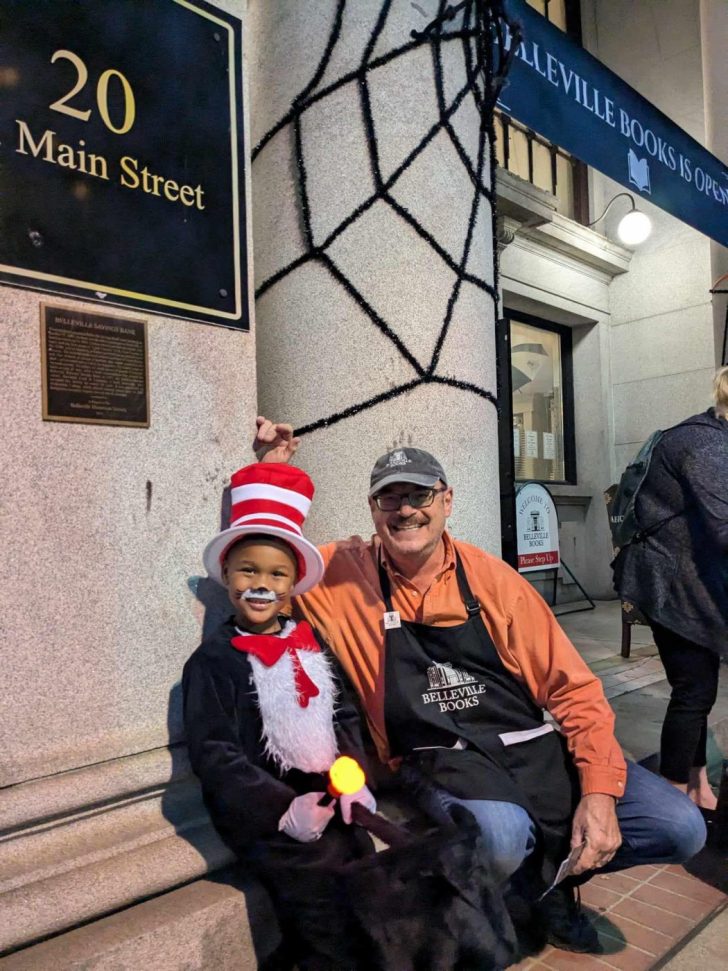
Belleville Books welcomes trick-or-treaters. Courtesy of Steve Matthews
While Belleville no longer has a dedicated queer bar, the rainbow-adorned Main Street offers plenty of affirmation. Every bar participates in Pride, and several host drag shows and LGBTQ-themed events. Beyond nightlife, community activities flourish: there’s a hiking club, a monthly book club at Belleville Books—a converted bank building opened by a gay couple from Salt Lake City—and social neighbors from around the country.
After the cover was teased out, countless Belleville residents commented on social media. This comment is from Henry Juhala:
Thanks for posting this. I am a proud out gay resident of Belleville.
In 2001 I was relocated by a company transfer from Los Angeles to St. Louis. I knew I did not want to live in Missouri. I did my research and chose specifically to move to St. Clair County. First to O’Fallon. Then 11 years ago to Belleville.
I have since retired. I considered maybe moving back to L.A. Or elsewhere. Yet, again, after much research, I chose to remain in Belleville because of 1) what you mention above as regards it being a welcoming and secure place for all people and 2) because it is also one of the most affordable suburbs in the nation – especially for those of us who are now in our senior years.
I still get a lot of the amenities of a large city like St Louis, but the security of a “welcoming” and affordable home like Belleville. Importantly, if I want or need to go into St. Louis, I have the convenience of Metrolink passenger rail almost literally at my back door. It is such a blessing.
Notably I can attest to several refugees from “red states” who have recently moved into Belleville to escape what is happening in their own states. I first started seeing the phenomenon when Roe v. Wade was overturned. Immediately I saw a family from St Louis suburbs move here with 3 kids, 2 of them girls of high school and college age who wanted to get out of that red state environment. The third child was a young gay man. All were fearful of what was happening individually to each of them in their Missouri community.
Now I see people moving into Belleville with much more frequency for similar political reasons and out of concerns for the safety of family members who were not the typical norm of red states like Florida or Texas. These exiles are now instead finding family and home in Belleville and nearby communities. I for one welcome them as neighbors.
So, thank you to Belleville and its leadership. I am proud to be part of the community.
In an increasingly hostile world, Belleville stands as a rare refuge: a blue town in a blue county in a blue state, and it’s just across the river. The message from its residents is clear—you are welcome here.
Signal Hill is another great Belleville gayborhood. See Tai Davis’s latest design column, which includes Interior Designer Mike Wyrock’s Signal Hill home.
Best Gayborhood For Rehabbers
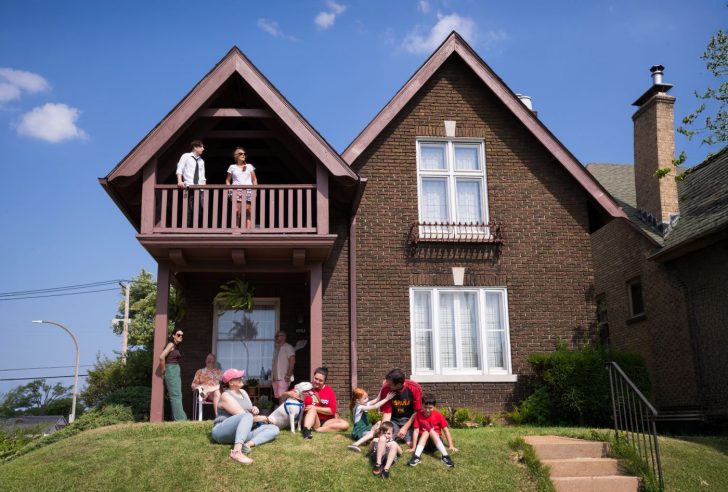
Kyla Oudshoorn (on her balcony) hosts neighbors.
 Carondelet/ Patch
Carondelet/ Patch
Founded as a French village in 1767, the eastern part of Carondelet has some of our region’s oldest housing stock.
For nine years, Realtor Kyla Oudshoorn has made her home in the quirky, scrappy Carondelet/Patch part of the neighborhood, which runs between the Mississippi River and I-55, and from Bates to the county line (the plenty-gay Carondelet neighborhood continues west of I-55 to Grand, but the older section east of I-55 maintains a distinct identity). “The area has a small-town feel and a warm, welcoming attitude,” Oudshoorn says. “To support our LGBTQ+ businesses is easy. Our lesbian watering hole, Hummel’s Pub, sits side by side with our gay bar, Bar:PM, in the 7100 block of S Broadway, and on the Ivory Triangle, you’ll find the famous [queer-owned] Sugarwitch ice-cream sandwich shop. World-famous drag queen Bonnie Blake called Carondelet home for decades, and drag shows are still a staple at our LGBTG+ bars today.”

Best Gilded Age Gayborhood
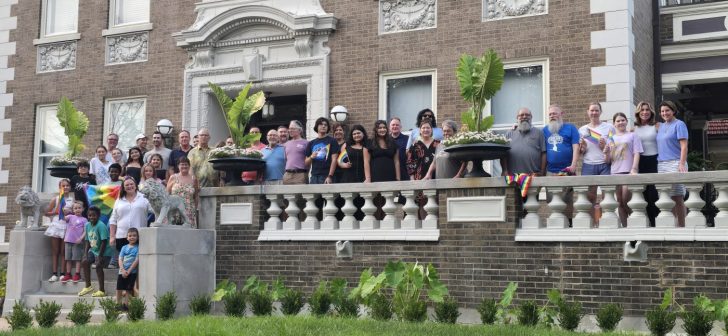
Justin and Tedd Trabert host neighbors.
 Compton Heights
Compton Heights
The gilded age mansions of Compton Heights stay in families for generations. As some owners began fleeing for suburbs, the LGBTQ community began buying and restoring the Beaux Arts and Tudor Revival estates. Today, families with children are back, and they blend beautifully with the community, as I learned during the photo shoot at the palatial home of Justin and Tedd Trabert.
“We searched twenty years for good neighbors. This is a version of Mayberry. We’ve found it to be loving and accepting,” said Shanna Kar, who attended the photo shoot with her husband Arindam and their four children.
If you aren’t in the market for something so grandiose, the northern end of the neighborhood offers comparatively smaller homes, and even condos.
“Compton Heights is a neighborhood with rich diversity and LGBTQ+ storied history,” says local resident C. Paul Bott. “It’s an honor for my husband and I to be able to add our own queer family’s story to the fabric of this beautiful and historic neighborhood.
“My husband and I live on Geyer Avenue, joining several other gay households when we moved into Compton Heights six years ago,” Bott says. “Within three houses, we have a lesbian couple to the east and another gay couple to the west. We’ve jokingly suggested proposing the renaming of Geyer to Gayer Avenue.”
Best Nightlife Gayborhood
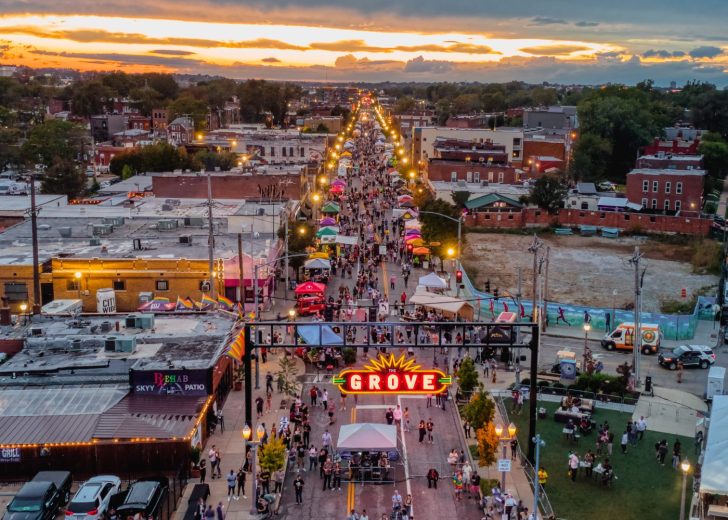
Photo credit: Christopher Taber
 The Grove/ Forest Park Southeast/ Botanical Heights
The Grove/ Forest Park Southeast/ Botanical Heights
Generally speaking, Grove residents are not around for a long time, they’re around for a good time. The undisputed capital of St. Louis LGBTQ+ nightlife, the district is filled with fashionable, high-end apartments and urbane new houses. Its proximity to high-paying job centers, coupled with the urban amenities, makes the Grove appealing to young, upwardly mobile transplants.
Flanking the Grove are the less transient Forest Park Southeast and the Botanical Heights neighborhoods. Just John co-owner John Arnold lives in a contemporary, custom-built Botanical Heights home with his husband Adam.
“We love living in Botanical Heights for its perfect blend of historic charm and fresh, creative energy,” says Arnold. “Here, beautiful early 20th-century architecture sits alongside thoughtfully restored homes and sleek modern builds. We’re just steps away from some of the city’s best restaurants, bakeries, and coffee shops—true foodie heaven. The community is close-knit, with neighbors who know each other and take pride in keeping the area vibrant and welcoming. And with the Missouri Botanical Garden, Tower Grove Park, the Grove, and countless cultural gems just minutes away, we still get to come home to our peaceful, tree-lined street.”

Best Hidden Gem
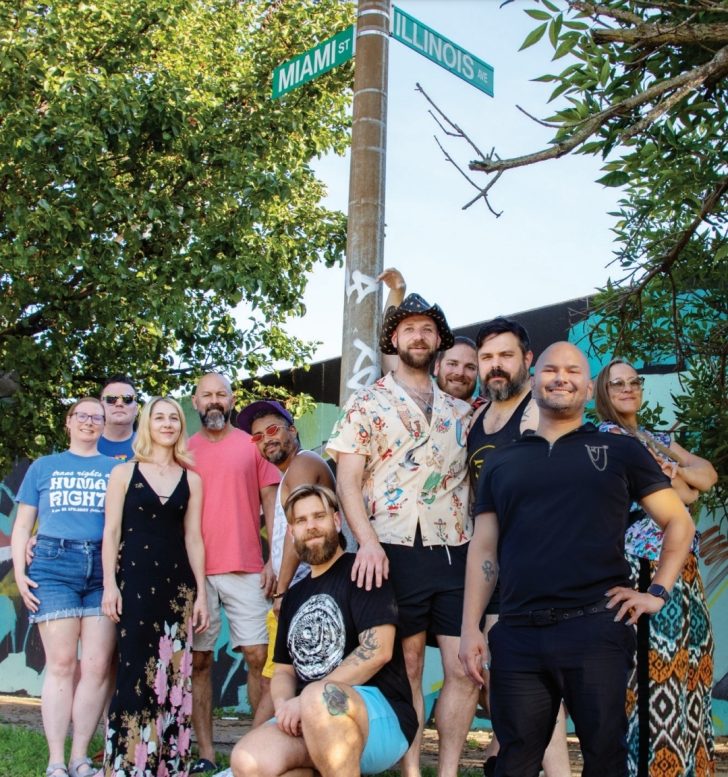
Marine Villa residents. Photo credit: Zac Lassen
 Marine Villa
Marine Villa
While the high-profile stretch of Cherokee Street west of Jefferson gets most of the attention, with its vintage shops, Mexican bakeries, punk dive bars, art galleries, tattoo parlors, indie boutiques, and street murals, Cherokee east of Jefferson feels more shaded, lush, established, and even a bit mysterious. Long known as Antique Row, Cherokee slices between Benton Park to the north and Marine Villa to the south.
If you’re looking for a high concentration of highly social LGBTQ folks, you should check out the 3500 block of Illinois, home to Just John co-owner Jeromy Ruot, witchcraft author and Out In STL contributor Eron Mazza, and many other highly visible folks. “It’s always nice to know we’re surrounded by neighbors who share our point of view, and don’t judge us for being poly,” Mazza says. “It’s a place where I can be myself.”
Mazza says the nearby Cherokee businesses are all welcoming, and that a favorite neighborhood hangout is the Saturn Lounge. “It’s a retro, modern, vintage vinyl record bar with a cozy vibe, earth tones,” he enthuses. “It’s modern and jazzy.”
Most Beautiful Gayborhood
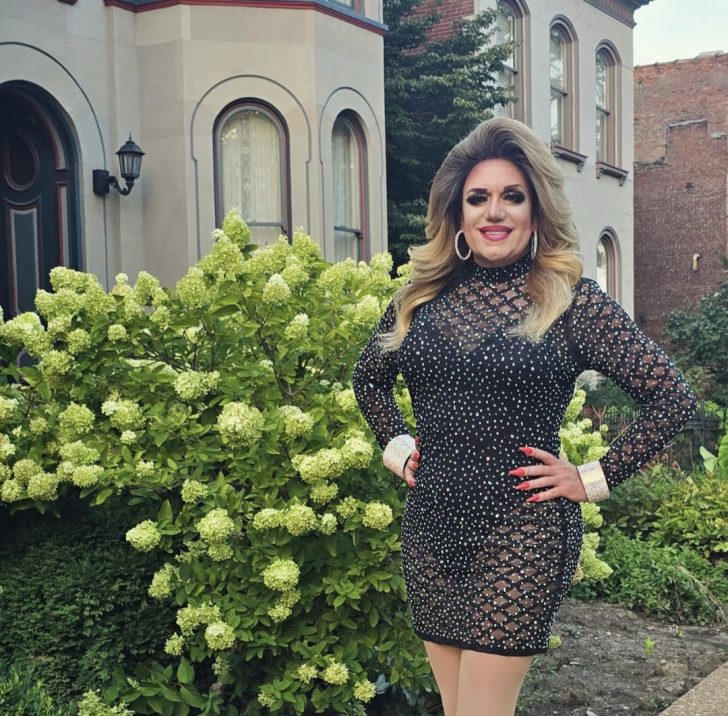
Jade Sinclair
 Lafayette Square
Lafayette Square
Lafayette Square is an OG gayborhood known for two types of “painted ladies,” one architectural and the other not.
Socialites Russell Jackson and Alex Gutierrez left their famed Portland Place mansion (long owned by a 7-up heiress, and highlighted in both the Wall Street Journal and St. Louis Post-Dispatch) for a circa-1897 converted firehouse with views of the Arch.
“We love living in Lafayette Square!,” Jackson, who lived in Manhattan for 23 years, enthuses. “It has the historic architecture that we love and ten or so terrific restaurants and bars that we can walk to easily. The latter is something we loved about NYC, and it made us feel instantly at home in Lafayette Square. The people you encounter are uniformly kind, approachable and diverse.”
While Lafayette Square is known as an expensive neighborhood, there are some surprisingly affordable ($150 – $180k) condos along Hickory between Missouri Avenue and Jefferson. That one block alone includes at least seven LGBTQ households, including that of Prism star Jade Sinclair.
Most Tight-knit Gayborhood
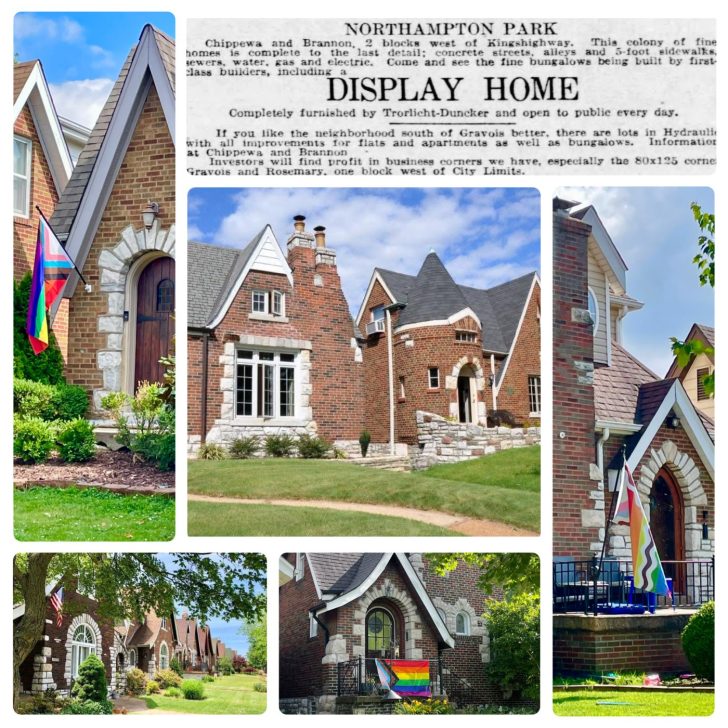
Courtesy of Chris Burbach
 Northampton
Northampton
A beloved lesbian bartender moved to Northampton in 1997, and while she has since passed, today more than 60% of the homes on that block are lesbian owned. Several of the residents initially planned to fully participate in this feature, but because of the Trump-era hate our community is facing, they only felt comfortable sharing their thoughts, not their names.
“We are super protective, and as homes become available, we look for the right fit,” says one neighbor we spoke with. “If someone is running late getting home, someone will take their dogs out for them. We all even travel together. Since we have been friends for so long we are our own little community, which was really nice during Covid.”
Chris Burbach is another longtime resident. “The Northampton neighborhood of St Louis, my home for the past 30 years, is comprised of many smaller neighborhoods. The most iconic of these is Northampton Park, built in the 1930s in the classic St Louis ‘gingerbread’ style. The 5200-5400 blocks of Tholozan, Mardel and Lindenwood Avenues have long been a magnet for the LGBTQ community. When my ex-partner and I purchased our home in 1995, there was already a lesbian couple and gay male couple on our block, and there were anecdotal stories of gay couples back to the 1940s. In the past 30 years, the LGBTQ population of couples and singles has grown exponentially, while the overall demographics have gotten younger and thoroughly socially progressive.”
Most Social Gayborhood
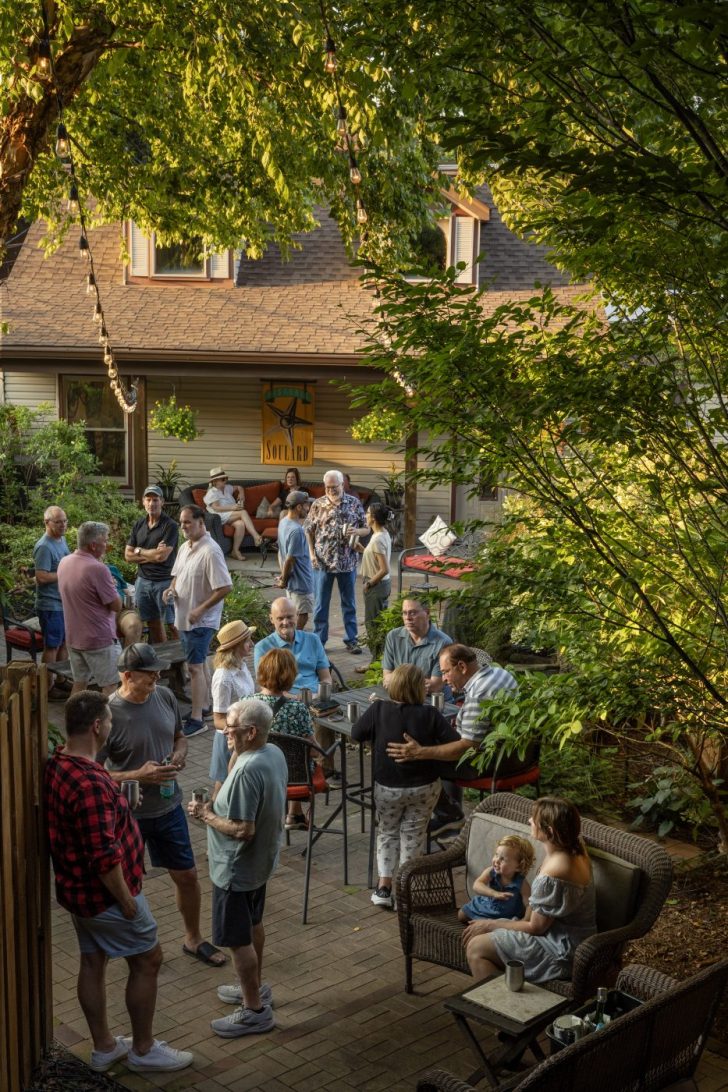
Garden party at the home of John Wallace III and Neal Thompson. Photo credit: Geoff Story
 Soulard
Soulard
One could argue that socializing is the entire point of living in Soulard.
Called “The Island” by many of its cocktail-loving, golf-cart-driving residents because of the way the river and highways cut it off from everywhere else, Soulard is the oldest intact neighborhood in the city, and is thought of as St. Louis’ own French Quarter because of its French origin, its massive Mardi Gras celebrations, and its overall drunkenness — “soûlard” even means “drunkard” in French.
(This reputation drives architecture historian Nathan Jackson crazy, because while the area was founded by the French, it was largely built and settled by German immigrants).
The area has had a sizable LGBTQ population since at least the seventies, when several bars catering to our community opened up. At that time, many of the historic brick homes were abandoned, with some going for as little as a dollar per square foot. Today, property values in Soulard are among the city’s highest.
The crème de la crème of Soulard, according to “Maven of Mardi Gras” Luann Denten, is an area nicknamed “Soulard Heights,” which runs from Ann south to the brewery, and from 9th to I-55. “Soulard Heights is old money,” the Maven says. “It’s the garden area to a great extent. This is where the beer barons lived, and many of their houses are still homes today.”
Because it’s the highest part of the neighborhood, it’s the only part of Soulard with river views.
John Wallace III and Neal Thompson graciously showed us around their circa 1875 Second Empire home, which they’ve largely restored by hand over the past three decades. Their garden party is pictured.
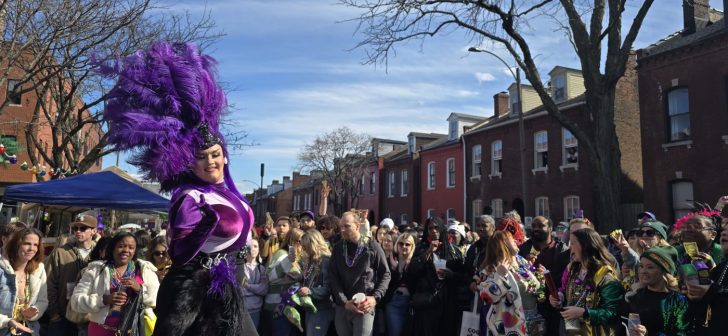
Amazing Grace of the Belles of Bevo. Photo credit: Chris Andoe
Friendliest Gayborhood
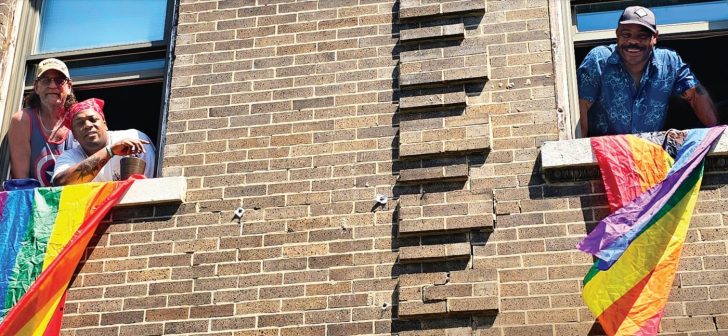
Mark Rumback and Kyle Lee host Benton Park neighbor Jesse Jackson.
 Benton Park
Benton Park
Benton Park is seen as Soulard’s calmer sister. Like Soulardians, you’ll probably drive a golf cart to the bar, but you’ll then come home and not have to worry about rowdy drunks peeing on your front steps.
Chuck Evans landed in the Grove after moving from Chicago, but after a few years he decided he felt more at home in Benton Park. “I feel closer to queer residents in Benton Park,” Evans says. “I feel the community of Benton Park is a bit tighter and friendlier. I feel like I’ve met more Benton Park folks and I’ve only lived here a few months. Many of my closest friends and chosen family live in Soulard and Benton Park. I can head out to very queer establishments, and I’m usually talking with people that actually live in the neighborhood.”
Most Well-Rounded Gayborhood
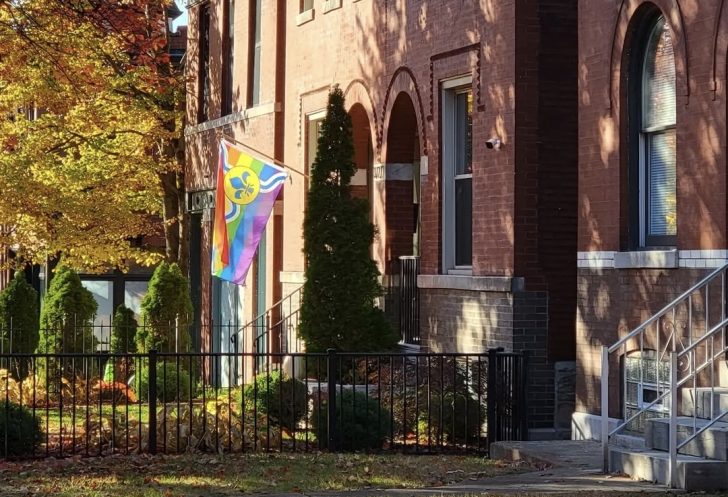
Tower Grove South. Photo credit: Chris Andoe.
 Tower Grove South
Tower Grove South
Our 2018 writeup on Tower Grove South has held up well.
You would be hard-pressed to find a more well-rounded neighborhood for LGBTQ people than Tower Grove South. Want a lesbian-owned social-justice-oriented coffee shop? OK! A drag bar within stumbling distance of your door? Grab your dollars! An LGBTQ-focused twelve-step program? Step right up. Endless Instagram-worthy international food options, food trucks, and an all-night diner? A buffet of options! Affirming, rainbow-flag-flying churches? Praise! A place to buy that last-minute sex toy, or get a replacement key for your handcuffs? Take your pick, and bring your trick! Neighbors who broadcast their liberal beliefs on yard placards? More good signs! Your own world-class pride festival, attracting upwards of 10,000 to your own neighborhood park? Well, aren’t you precious? And in the right place!
We’ve lost one all-night diner, but the Buttery is still going strong. And Tower Grove Pride has tripled in size.
This 1.5-square-mile area has a wide variety of housing stock, from the grand homes of Tower Grove Heights to small bungalows, with many multifamily options throughout. If you’re looking for community, you can’t go wrong anywhere in Tower Grove South, but we’re taking this report to new heights by focusing on two concentrated areas atop hills where you can be guaranteed that a neighbor will allow you to borrow some sugar. The two highest parts of Tower Grove South are among the queerest, but with distinct personalities.
Tower Grove South: 4100 Block of Oleatha, Atop Oak Hill
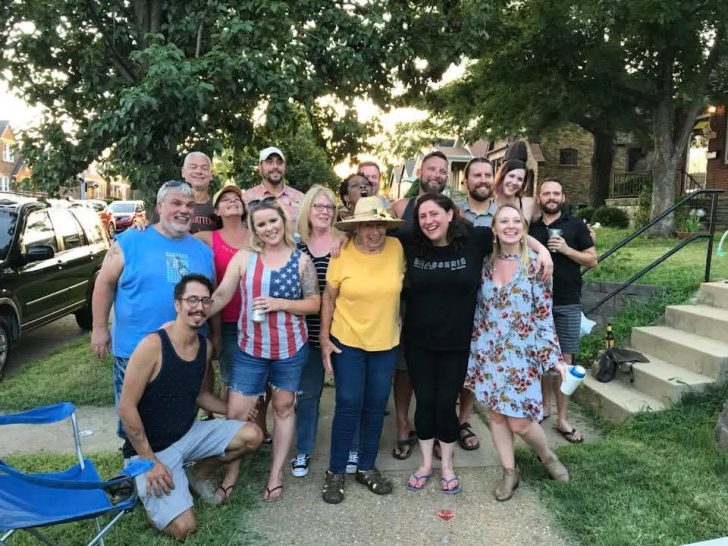
The Residents of the 4100 Block of Oleatha. Photo credit: TakeMoorePics Photography
Photographer and community organizer Mark Moore has lived in his charming 1.5 story house on the quiet block for 25 years. “The 4100 block of Oleatha celebrates diversity proudly, unifying neighbors with respect and appreciation for each other,” he says proudly. “Whether we are gay or straight, single or married, younger or more mature, we are neighbors, we are friends. We lift each other up. We help each other. We celebrate new neighbors and we miss them when their stay here is over. We are Oleatha proud. We are Tower Grove South strong.”
Tower Grove South: Grey Fox Hills
Many people like to romanticize what our great gayborhoods were before they were gentrified, wistfully pondering what life would’ve been like if only they could have been a part of them then.
Well, hon, have I got a deal for you.
The blocks surrounding our city’s oldest LGBTQ bar, Grey Fox Pub, are known as “Grey Fox Hills” in the community. It’s the least gentrified part of Tower Grove South, a place where your credit score isn’t as important as your street cred.
It’s also where I live.
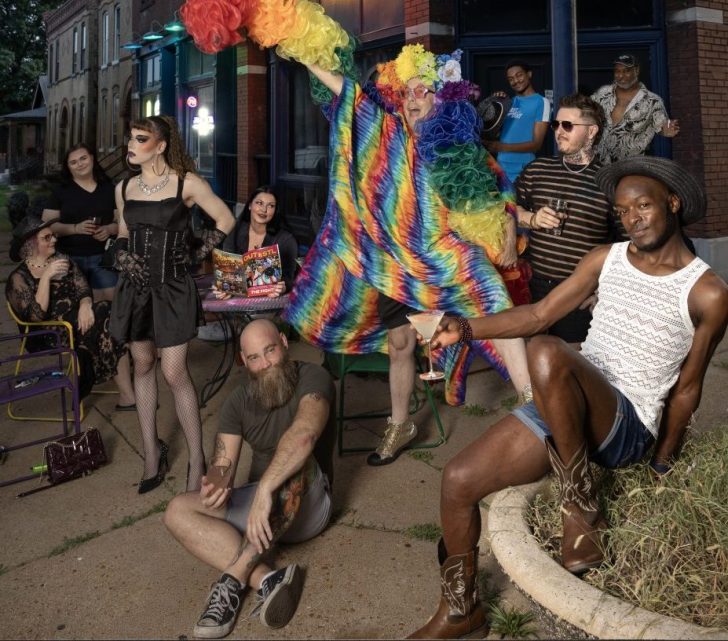
Photo by Geoff Story
When two men were ejected and banned after calling patrons the n-word and throwing trash at them in 2022, they spent months wailing on the horn in the middle of the night to punish the entire block, until a fed-up neighbor smashed their headlights and taillights out. When a friend working the night shift planned to borrow my car, I informed the intense and highly vigilant neighbor behind me. “Thanks, brother,” he replied. “I don’t wanna shoot anybody that doesn’t need to be shot.”
It’s a community-minded place where folks come together, organize and resist. In the aftermath of the most recent presidential election, St. Paul United Church of Christ opened its doors for several LGBTQ legal events. Sanctuary Church is another community anchor, led by a gay Black pastor.
Grey Fox Hills is highly walkable. Not only can residents toddle down to the bar to see high-energy drag shows, we can walk to two markets offering fresh food, as well as to an array of late-night and international food options.
You’ve heard about the “Alphabet Mafia?” We’ve got all the letters here. Hell, even the neighborhood squatter is gay.
In a time when it feels we’re under siege by those in power and their minions—some literally carrying Nazi flags through the streets of American cities—the queer and allied residents of Grey Fox Hills take comfort in our tight-knit, street-smart self-sufficiency, feeling we are best positioned to weather the apocalypse.

Best Suburban Gayborhood
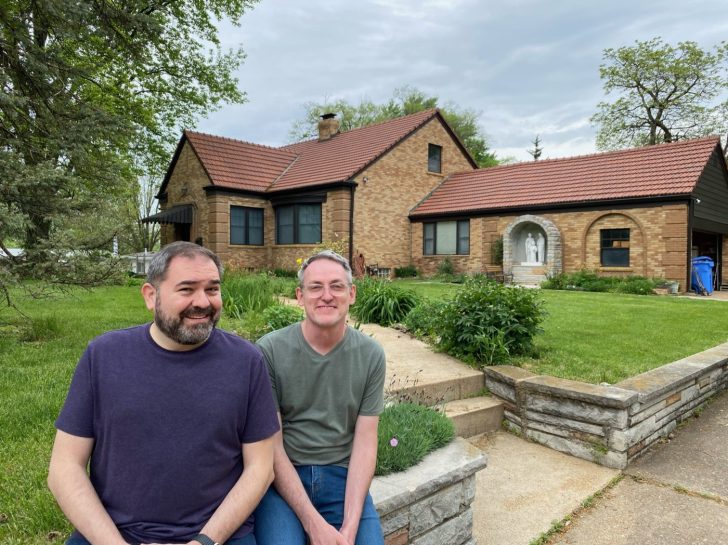
Ed Reggie and Scott Emanuel love the diversity of Florissant.
 Old Town Florissant
Old Town Florissant
Ed Reggi is passionate about Florissant, and wrote the following.
Moving to Florissant in 2021 was a leap of faith. After 15 years in downtown St. Louis, my husband, Scott, and I were city people through and through. We initially resisted the idea of a suburban move, worrying we’d lose living in the urban corridor and, more importantly, the vibrant queer community we cherished.
But then we found our home: an almost 90-year-old Mediterranean-style farmhouse. We fell in love with its character, but it was our new neighbors who sealed the deal. What we discovered was a community far richer than we imagined. Florissant, established in 1786 by French settlers, has grown into a diverse city of over 50,000, with a rich blend of families. A community with the first Thai Temple in the region, West African shops and restaurants, and vibrant, growing Mexican culture. We realized our concerns were misplaced.
Within six months, we were bumping into other LGBTQ+ residents at local restaurants and shops. Unlike some places we’d considered in the county, Florissant feels safe and welcoming. During our first Pride Month here, the city’s website even displayed rainbow colors, a sign of public acceptance that resonated with us.
Old Town Florissant, one of the area’s most historic neighborhoods, proudly displays LGBTQ+ welcoming signage year-round. They call this the “City of Flowers,” and what we’ve learned is that it’s a bouquet of beautiful, diverse people. We may have come for a house, but we are staying for a community that embraces everyone.
Making Your Move
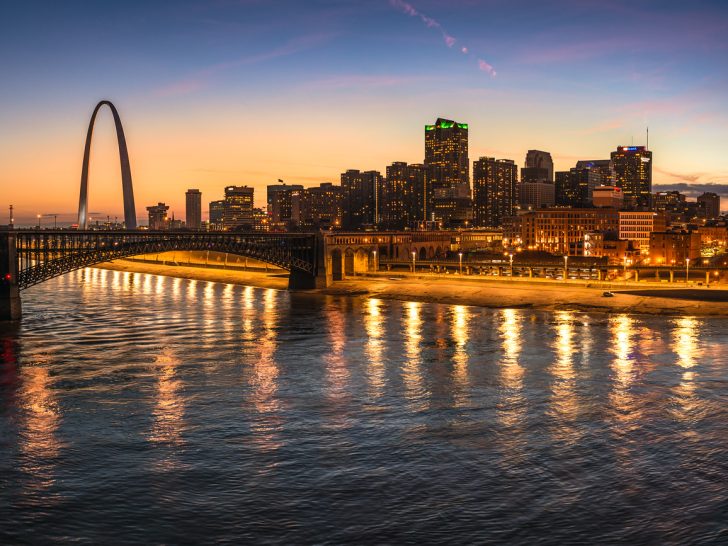
Photo credit: Christopher Taber
While our 2018 feature highlighted LGBTQ-friendly neighborhoods, the rosy, overarching assessment in that era was that they weren’t all that necessary anymore, pointing to community acceptance even in places like Jefferson County. Obviously, political conditions have clearly deteriorated since then. Community members are weighing questions like whether it’s better to live in a deep blue island in a red state, or in the red part of a blue state. Today we make sober calculations on where we should live — even if we decide on a tipsy neighborhood like Soulard.
For those who followed our readers’ advice in 2018, we’re glad to see that those gayborhoods are still going strong, evidenced by all five making their second appearance on the list.
The bi-state St. Louis region offers a remarkable variety of options. Whatever gayborhood you choose, you have future neighbors waiting to welcome you home.
